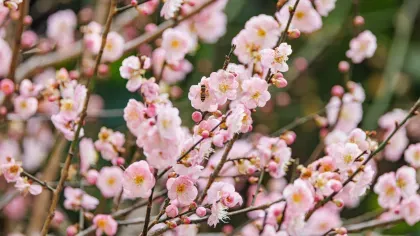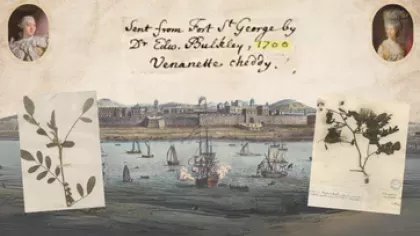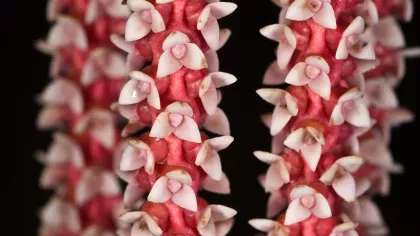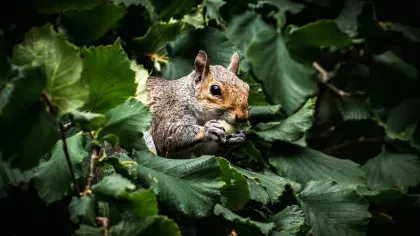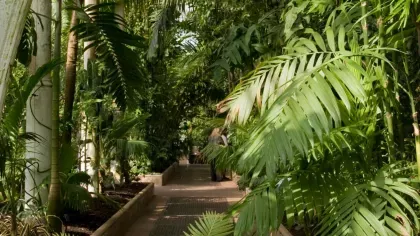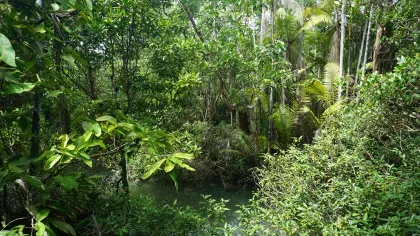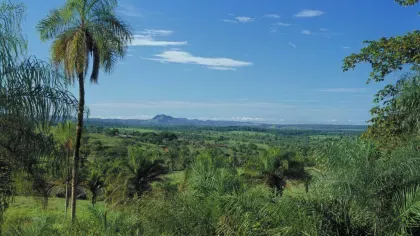Tropical Important Plant Areas in the British Virgin Islands
Kew’s UK Overseas Territories (UKOTs) team recently returned from a successful launch of the Tropical Important Plant Areas project in the British Virgin Islands. Rosemary Newton reflects on the highlights of this trip.

The Caribbean is a hotspot for biodiversity, with a native flora of around 11,000 seed plant species and a high proportion of endemism. Within the Caribbean, the British Virgin Islands (BVI) along with the US Virgin Islands and Puerto Rico comprise a biogeographical unit known as the Puerto Rican Bank.
The BVI include around sixty islands and cays, the largest of which are Anegada, Tortola, Virgin Gorda and Jost Van Dyke. The islands are volcanic in origin and are hilly and rugged, with the exception of Anegada, which originated from a submerged limestone reef and is virtually flat with a maximum altitude of merely eight metres.
The islands were likely entirely covered in forests prior to the arrival of Europeans. Subsequent human activity has transformed large areas through habitat loss, overharvesting and the introduction of non-native species. Consequently, there is a great need to identify important areas that most need protection and conservation.
Tropical Important Plant Areas project launch
Tropical Important Plant Areas (TIPAs) are target sites for plant and habitat conservation, identified by the presence of threatened species, threatened habitats and/or high botanical richness. Although TIPAs are not legal designations, they can inform the protection and management of sites for biodiversity conservation.
The TIPAs project in BVI was launched last month at a workshop held at the J.R. O’Neal Botanical Gardens in Tortola. This two-year international collaboration aims to identify and conserve TIPAs in BVI. It is led by the Kew UKOTs team and staff from the National Parks Trust of the Virgin Islands (NPTVI).
The main aims of the workshop were to:
- Introduce the concept of TIPAs to stakeholders (including the government, NGOs and the local press)
- Identify data sources and data gaps for plant species and habitats which are locally or regionally threatened
- Agree an implementation plan for the identification of TIPAs in BVI
The workshop was well attended and generated much interest and enthusiasm in the project from both stakeholders and collaborators.
Rare species’ range expansion
Following on from the workshop, the UKOTs team and collaborators embarked on field trips to previously unexplored areas on Tortola, Beef Island, Virgin Gorda, Great Tobago and Prickly Pear. The aim was to search for new, rare and threatened plants, and also to map the occurrence of invasive plant species. These expeditions discovered previously unknown populations of rare endemic species, enabling a more accurate calculation of their distribution and therefore their conservation status.
Some rare species (including Malpighia woodburyana, Metastelma anegadense, Croton fishlockii and Maytenus cymosa) were found to have a greater distribution than previously thought. Herbarium specimens, DNA samples and spirit specimens were collected from these new populations. Live plant material was also collected for propagation for ex-situ conservation in the J.R. O’Neal Botanical Gardens.
Native plants threatened by introduced pests
In the field it quickly became apparent how introduced pests can decimate local populations. The agave snout-nosed weevil (Scyphophorus acupunctatus) from Mexico has caused the death of many of the regional endemic Agave missionum. The larvae bore holes in the leaves allowing micro-organisms to invade, which rots the plant.
A potential threat to the Cactoideae (columnar cacti) is Hypogeococcus pungens, commonly known as the cactus mealybug. This pest is already devastating cacti such as Melocactus intortus, Pilosocereus royenii and the endangered Leptocereus quadricostatus in Puerto Rico. While it has not been found in BVI it is probably only a matter of time before it arrives on these islands. Even though Cactoideae are locally abundant in many areas of the Caribbean, this might rapidly change as the mealybug spreads.
Collections of seeds of these species for ex-situ conservation at both the J.R. O’Neal Botanical Gardens and Millennium Seed Bank at Kew will hopefully ensure their survival and provide a local source of seed for re-introduction if needed.
Mapping and control of invasive plant species
Introduced plants are also threatening native plants in the region. According to the Flora of the West Indies, there are 263 species listed as non-native in the Virgin Islands. Although a relatively small proportion of these introduced species become invasive, those that do can negatively impact the indigenous flora.
Some of the most aggressive invasives in BVI are Scaevola taccada (beach naupaka) and Casuarina equisetifolia (Australian pine) found on the beaches and in disturbed, sandy soil, and Leucaena leucocephala (wild tamarind) and Calotropis procera (giant milkweed) inland.
On Great Tobago, which is uninhabited and protected as a national park because it hosts one of the largest populations of nesting frigate birds in the region, we recorded several individuals of Calotropis and Leucaena. A programme is currently underway to remove feral goats from this island as they are indirectly threatening the frigate bird breeding colony by browsing any native tree seedlings. Cameras have been installed at five locations on the island to gather information on the rate of natural vegetation recovery before and after removal. It is likely that the goats have kept the spread of Calotropis and Leucaena in check, so it is essential that close monitoring and, if necessary, regular removal of these invasive plants on Great Tobago takes place once the goats have been removed.
Capturing local knowledge on the medicinal use of native species
On the second last day of our trip we were fortunate to meet Benjamin Peters, a local bush doctor in Tortola. He showed us a variety of different plants which he grows on his farm and enthusiastically explained what each was used for. Most of the plants are used to make teas to treat ailments such as high fevers, stomach aches and infections. He also brought along a liquid made of honey, mint (a species of Mentha), tamarind (Tamarindus indica) and a secret ingredient for treating sore throats. He persuaded us all to try a teaspoon of this mixture, which had quite a pleasant taste and reminded me a little of cough mixture. Unsurprisingly, for a few hours thereafter it relieved my rather persistent cough which had developed following a mild chest infection several days earlier.
The next two years…
Future activities of the TIPAs project will include:
- The digitisation and georeferencing of priority species from the Puerto Rican Bank to enable the production of distribution maps
- Generation of field identification and collection guides for partners and field teams
- Identification of core survey areas using satellite imagery for further field surveys and collecting
- Processing and digitising new collections
These activities will enable the production of TIPAs maps for BVI and the publication of a report. This will culminate in a regional workshop for the Puerto Rican Bank conservationists to review the TIPAs approach used in this project and to explore the possibility of other collaborations to identify TIPAs in the US Virgin Islands, Puerto Rico and other Caribbean UKOTs.
Acknowledgements
Partners include the Royal Society for the Protection of Birds (RSPB), the United States Fish and Wildlife Service (USFWS), the Department of Natural and Environmental Resources (DNER) of Puerto Rico and the University of Puerto Rico Mayagüez Campus Herbarium (MAPR).
My grateful thanks to Martin Hamilton for his tireless efforts in organising transportation, accommodation, logistics, the workshop, equipment and field work and ensuring that everything proceeded smoothly.
I was privileged to be in the field with Colin Clubbe, Martin Hamilton, Sara Bárrios, Michele Sanchez, Tom Heller, Marcella Corcoran (Kew UKOTs Team), José Sustache (DNER, Puerto Rico), Omar Monsegur (USFWS, Puerto Rico), Jeanine Vélez (MAPR), Nancy Woodfield-Pascoe, Natasha Harrigan, Ronald Massicott, Denville Hodge and Keith Grant (NPTVI) who all so willingly shared their expertise and knowledge of this unique flora.
The TIPAs Project is funded by HSBC.
References
Acevedo-Rodríguez, P. (1996). Flora of St. John, US Virgin Islands. Memoirs of the New York Botanical Garden 78: 1-581.
Acevedo-Rodríguez, P. & Strong, M. T. (2008). Floristic richness and affinities in the West Indies. The Botanical Review 74: 5-36.
Bárrios, S. (2015). Conservation genetics of Vachellia anegadensis, a British Virgin Islands endemic plant species. MSc Thesis, The University of Reading, Reading, UK.
CABI. Invasive Species Compendium:Hypogeococcus pungens (cactus mealybug). (2016). Available online
Clubbe, C., Gillman, M., Acevedo-Rodríguez, P. & Walker, R. (2004). Abundance, distribution and conservation significance of regional endemic plant species on Anegada, British Virgin Islands. Oryx 38: 342-346.
Gann, G. D. & Taylor, N. P. (2013). Leptocereus quadricostatus. The IUCN Red List of Threatened Species 2013, e.T44008A2991465. Available online
Hamilton, M. A. (2015). Boraginaceae Varronia rupicola (Urb.) Britton: biogeography, systematic placement and conservation genetics of a threatened species endemic to the Caribbean. PhD Thesis, Birkbeck, University of London, London, UK.
ISSG Invasive Species Specialist Group. (2015). The Global Invasive Species Database (GISD): Scyphophorus acupunctatus. Version 2015.1. Available online
Maunder, M., Leiva, A., Santiago-Valentin, E., Stevenson, D. W., Acevedo-Rodríguez, P., Meerow, A. W., Mejía, M., Clubbe, C. & Francisco-Ortega, J. (2008). Plant conservation in the Caribbean island biodiversity hotspot. The Botanical Review 74: 197-207.
Taylor, N. P. (2013). Melocactus intortus. The IUCN Red List of Threatened Species 2013, e.T152029A588980. Available online



